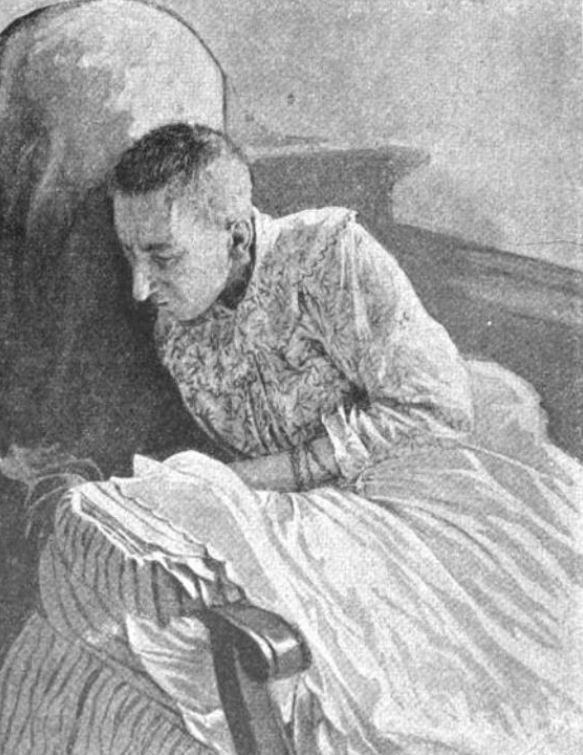Blanche Monnier: The girl who was locked away for 25 years
– by NT – Leave a Comment

In 1901, a letter showed up at the Paris Attorney General’s office that no one could ignore. The writer revealed a shocking truth: Blanche Monnier, a woman from Poitiers, had been locked away in a small attic room for a staggering 25 years.
The letter painted a grim picture of Blanche’s condition — “half-starved, living on a putrid litter,” with everything around her covered in filth.
When the police arrived, they were met with a scene straight out of a horror story.
Born into a well-respected family
To fully grasp the shocking and tragic tale of Blanche Monnier do Marconnay, we need to rewind to 1870s France, a time marked by revolutions and drama.
Blanche, born in 1849, came from a well-respected, conservative bourgeois family
in the French city of Poitiers. The town is a historic place with proud traditions, famous for its Romanesque churches. Both Blanches parents, Charles and Louise Monnier, had deep roots in the society.

Her mother, Madame Louise Monnier, was known for her charitable works, even receiving a community award for her generous contributions. The family’s legacy was strong — Louise’s late husband had been in charge of a local arts faculty, and their son Marcel had become a law school graduate, working as an administrative official.
Marcel held his mother in high regard, while Blanche was a spirited, young woman who yearned to carve out her own path. With her thick, curly hair, big eyes, and vibrant personality, she was the picture of energy and independence, a stark contrast to the more traditional expectations placed on her by her family.
It was these very traits that would ultimately prove to be fatal for young Blanche. But in 1876, no one could have imagined what would happen to the popular socialite.
Vanished without a trace
That year, Blanche Monnier, drew the attention of many potential suitors. Described as “very gentle and good-natured,” she was widely regarded as a charming young woman, with her physical allure making her a sought-after match in society.
Given her family’s esteemed status, she was often in the public eye, and it seemed only a matter of time before she would find a suitable husband. But one day, she just disappeared.
At the time, Blanche was 26, still attending law school, and living at home — according to later news reports.
After a while, those close to Blanche began to wonder where she had gone. But they all received the same answer from her mother. Louise Monnier told people that her daughter had “gone away” or was traveling. Eventually, so much time had passed that many in the family and Blanche’s friends believed she had moved abroad. Since they never received any clear answers, people stopped asking about her.
No one had any idea that she was actually imprisoned in her own home, living under horrific conditions. It would take 25 years before anyone found her, and when she was finally discovered, an unimaginable story unfolded.
A mysterious note
On May 23, 1901, a mysterious, anonymous letter arrived at the office of the Paris Attorney General.
”Monsieur Attorney General, I have the honor to inform you of an exceptionally serious matter. A woman, a spinster, has been locked away in Madame Monnier’s house, half-starved and living in filth for the past twenty-five years,” the letter read.
When the police arrived at the Monnier villa to investigate, they were met with resistance. According to Crime Wire, Louise Monnier refused to let them in, even peeking her head out the window and ignoring their presence.
They then forced the door open and were hit by an overpowering stench. Heading upstairs, they discovered the source of the odor – a locked attic door, where the smell was the most intense.

After some struggle, the officers opened the door and managed to pry open a window that had been boarded up. Daylight finally filtered into the small room, revealing a grim scene. They forced their way into the attic, breaking down the padlocked door.
There, in the corner of the room, lay Blanche, now in her early 50s, emaciated and skeletal, squinting at the sunlight that barely reached her. Covered in old food, feces, and surrounded by bugs, she weighed barely 55 pounds. The conditions were horrifying, a stark contrast to the young woman she had once been.
One officer later recalled:
”As soon as light entered the room, we noticed, in the back, lying on a bed, her head and body covered by a repulsively filthy blanket, a woman identified as Mademoiselle Blanche Monnier. The unfortunate woman was lying completely naked on a rotten straw mattress. All around her was formed a sort of crust made from excrement, fragments of meat, vegetables, fish, and rotten bread. We also saw oyster shells and bugs running across Mademoiselle Monnier’s bed.”
Message on the filthy walls
According to an article in the New Zealand Times from 1901, during moments of clarity, Blanche had written on the filthy walls surrounding her: ”Shall I ever regain my freedom, or am I to be for ever consigned to this living tomb?”
The terrified woman was wrapped in a blanket and rushed to a hospital in Paris, where doctors initially feared she wouldn’t survive. She was severely malnourished, with matted hair that reached down to her knees.
As Blanche was carried out of the villa, her mother, Madame Monnier, then 75 years old, sat calmly at her desk in a beautiful black-and-white dress. She was immediately arrested and confessed to imprisoning her own daughter.
Reason for the imprisonment
According to Louise’s account, it all began one night in 1876 when Blanche quietly tiptoed up the stairs to her room, trying not to wake her mother and brother. What she didn’t know was that they were already awake and waiting for her upstairs.
Together, they had devised a plan: they would lock Blanche in a small attic room until she agreed to end her relationship with the lawyer she had fallen for. But Blanche was more determined than they anticipated, Louise later told the police. Once she adapted to the pitch-black darkness and realized there was no way out, Blanche decided to wait her mother out. However, Louise was just as stubborn and refused to release her daughter.
So, what was behind this whole ordeal? Why would Louise lock her own daughter away for 25 years? The answer lies in love.

After years of searching for a suitable match, Blanche finally fell for a man. The problem was that he wasn’t rich enough – and he didn’t come from an aristocratic family. He was a lawyer, but practically penniless. Some reports say he was much older than Blanche, while others describe her love as a young barrister with ”brain but no money.”
Blanche knew her mother, Madame Louise Monnier, would never approve of him.
At first, Louise told Blanche she would stay locked in the small attic room until she ended the relationship and agreed to find a more suitable husband. But the days turned into weeks, then months, and eventually years.
Louise Monnier’s last words
Even after Blanche’s beloved passed away in 1885, Louise refused to set her daughter free. The cruel grip of her mother’s control never loosened, and Blanche remained trapped in that tiny, dark room, her heart breaking with each passing day.
Hospital staff noted that despite Blanche’s extreme malnourishment, she was surprisingly lucid. She even expressed her joy at the simple pleasure of breathing fresh air again, calling it “lovely.” In many ways, it was nothing short of a miracle that she had survived at all.
After Blanche’s liberation, the case took another dramatic turn, capturing headlines across the globe. Louise Monnier, after sharing her account with the police, passed away from a heart attack in the prison infirmary one morning.
It had been only 15 days since her arrest, but her body couldn’t take the strain. The truth is, she was widely despised. Reports even described an angry mob gathering outside her home, seemingly seeking revenge.
It’s said that Louise’s last words were about her daughter: “Ah, ma pauvre Blanche,” she sighed.
Marcel Monnier
Blanche’s brother would face charges for aiding his mother in kidnapping and imprisoning his sister.
The trial began on October 7, 1901, and just a few days later, Marcel Monnier was sentenced to 15 months in prison. The courtroom erupted in cheers at the verdict – but that celebration didn’t last long. Marcel appealed the decision, claiming Blanche had never been imprisoned and was free to leave the house if she wished, but she chose not to.
On November 20, 1901, Marcel was acquitted. The court ruled that, despite his education as a lawyer, he lacked the mental capacity to intervene and free his sister. The judges criticized his inaction but noted that, at the time, the penal code didn’t clearly establish a “duty to rescue,” making it impossible to convict him under the law.
Who saved Blanche Monnier?
Over the years, many have wondered who was behind the letter that ultimately led to Blanche’s rescue. Addressed to the city’s public prosecutor, the mysterious note didn’t appear to have been sent through regular mail.
To this day, no one knows who delivered it. Some speculate it may have been written by a former soldier who was involved with one of the family’s maids but felt no loyalty toward the Monnier family. We may never know who wrote the letter, but without it, it’s clear that Blanche would likely have died in her small prison.

The story of Blanche Monnier, who spent 25 years in isolation, is shrouded in mystery and has been the subject of much speculation. While it’s clear she was confined to a tiny attic for decades, the exact details of her captivity are hard to verify. Early 20th-century newspaper reports were often biased or incomplete, making it difficult to get a clear picture of what truly happened.
What we do know is that Blanche’s ordeal captured widespread attention, particularly after André Gide’s 1930 book, La Séquestrée de Poitiers, which retold her story. Gide, a Nobel Prize-winning author, reportedly changed little of the haunting account except for the names of the main characters.
Blanche Monnier Netflix
As of now, there hasn’t been a feature film made about Blanche Monnier on Netflix or elsewhere. However, there are several documentaries on the topic, and a number of books have been written about her story.
While many questions remain about the details of her story, what’s undeniable is that Blanche’s courage in the face of unimaginable circumstances deserves to be remembered.
We may never fully understand the complexities of her life, but her story is one that continues to captivate and inspire. Don’t forget to share this incredible journey with others — sometimes, these hidden and tragic histories are the most important ones to remember.
